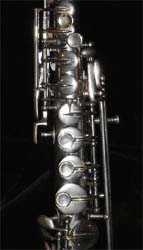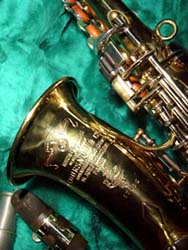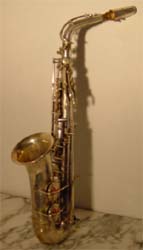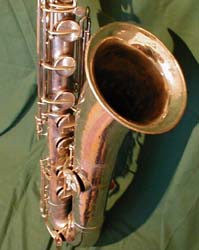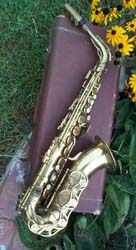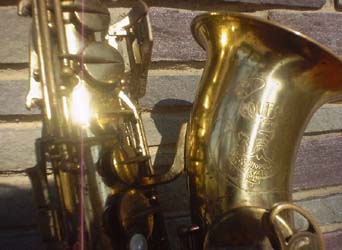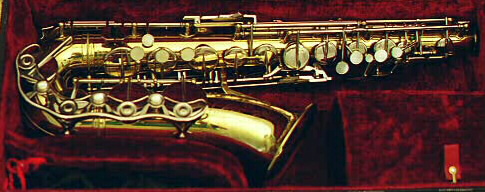 |
(1882 to 1980?)
Website Home
|
Couesnon (pronounced QUE-NON) is a model that has been around for quite some time. This is one of the several "conglomerates" of small French manufacturers. Some history: Couesnon was "estabished" in 1882 when Amedee Auguste Couesnon, the son-in-law of P.L. Guatrot, took over the directorship of Guatrot-Durand et Cie (read "Guatrot-Durand and company"). Guatrot, you may recall, was previously the seller of the Sarrusophone and was, thus, A. Sax's bitter rival. Couesnon was "reformed" in 1931, as Couesnon S.A. (read: "Couesnon, Incorporated") with the inclusion of L'Association Generale des Ouvriers, Feuillet, Guichard, Lecomte, I. Lot, Massin & Thibouville, Triebert, Marquet, and "several others". About this time, there seems to be a gap of a few years in their saxophone manufacture, and when it was started again, the design was completely different -- but not patented (the last Couesnon saxophone patent is dated 1935, and a new one doesn't appear until 1976). I believe it was at this point that Couesnon started to concentrate on their brasswind manufacture. Probably the most important thing to note is that Couesnon, in
a joint venture with Dolnet & Pigis, created one of the first
"modern" keywork patents on March 11, 1888 (FR189198)
-- this was a patent that: If you wish to look up a bit more history on Guatrot and Couesnon, take a peek at this eBay ad (hey, they plagarized me, I'll plagarize them. They've got nice pictures).
===== This historical information is distilled from New Langwill's Music Index and Frederick Hemke's Dissertation on the Early Saxophone |
| Early
Horns ("1900" Model) (1882 to 1936) |
||||||
|
Straight
Bb Sopranos |
. |
Curved
Bb Sopranos |
. |
Eb
Altos |
. |
Eb
Baritones |
| Here's a listing of all the early Couesnon model names, from "deluxe model" to "standard model", modifying the New Langwill Index to fit reality: Modele
Monopole ("elaborately" engraved) I don't have an exact idea, because I don't have enough examples, but it may also be the case that the "lower" models had dual-octave key and lacked pearl keytouches after 1913. I am not sure when Couesnon switched from split-bell-keys to left-hand-bell keys. It's even possible that there was a switch only on the upper models, or upper models were switched first. According to the New Langwill index, the date for these horns is found by looking at the number in the "grenade" ("pineapple") on the bell, so, e.g., "8" would mean "made in 1908". The main reason I call these "1900" models: a lot of them have "hidden" serial numbers (under a key, or some such), rather than on the bell, but you can always see an engraving on the bell that says (translated), "Universal Exhibition of Paris, 1900" -- and it's a lot easier than remembering the Series names. These horns have a very sweet sound -- I owned a "1900" bari -- but a lot are high pitch horns (Couesnons aren't labelled LP or HP.) This is the only other model I know of to use bevelled tone holes. The other is Martin -- and they're significantly different. Finally, a major note: post-1937 have a different label and address on the bell: "Couesnon SA, 105 rue Lafayette" |
||||||
| Series
I (Monopole model) (1937 to 1949; sn 1 to appx. 82xx) |
||
| Eb
Altos |
||
| Again, after Couesnon was reformed in
1931, there was a slight gap in sax manufacture (it may be that I just
haven't seen any horns from about 1931 to 1940). After this gap, these
art deco horns appeared. Bevelled tone holes gave way to rolled tone
holes. Left hand bell keys became right hand bell keys. Double-socket
necks are also introduced. The construction of these saxophones parallels only one other French manufacturer: SML. |
||
| Series
II (Monopole model) (1950 to 1980?) |
||
| Eb
Altos |
||
| This series is marked by slight keywork design changes and different engraving. There is no serial number chart extant for Couesnon. I do, however, find it difficult to believe that they produced saxophones after 1980, as their construction is far inferior to the Buffet SuperDynaction "transitional" models or S1, the Dolnet M70 or the Selmer Mark VII/S80. However, I put their production end date so late because of Couesnon's 1976 saxophone neck patent (FR2277393), which is demonstrated on a Monopole neck. |
||
| Donate to the Vintage Saxophone Gallery Website | ||
|
|
||
Website copyright © 1997-2006 by Pete Hales.
Pictures/sounds/etc. used herein may have their own copyright and most are used by permission.
If you feel any image or soundbyte used here is in violation of copyright or for information regarding use/reproduction of this website's content, please e-mail saxpics@gmail.com
Comments, corrections, suggestions or picture submissions: saxpics@gmail.com
